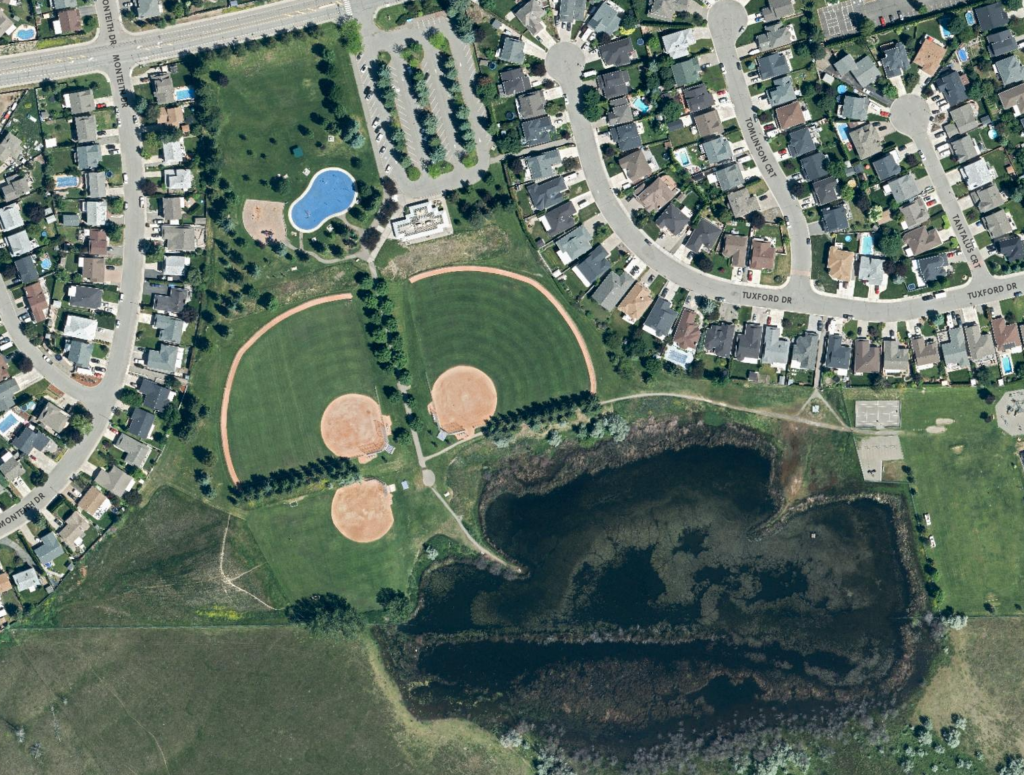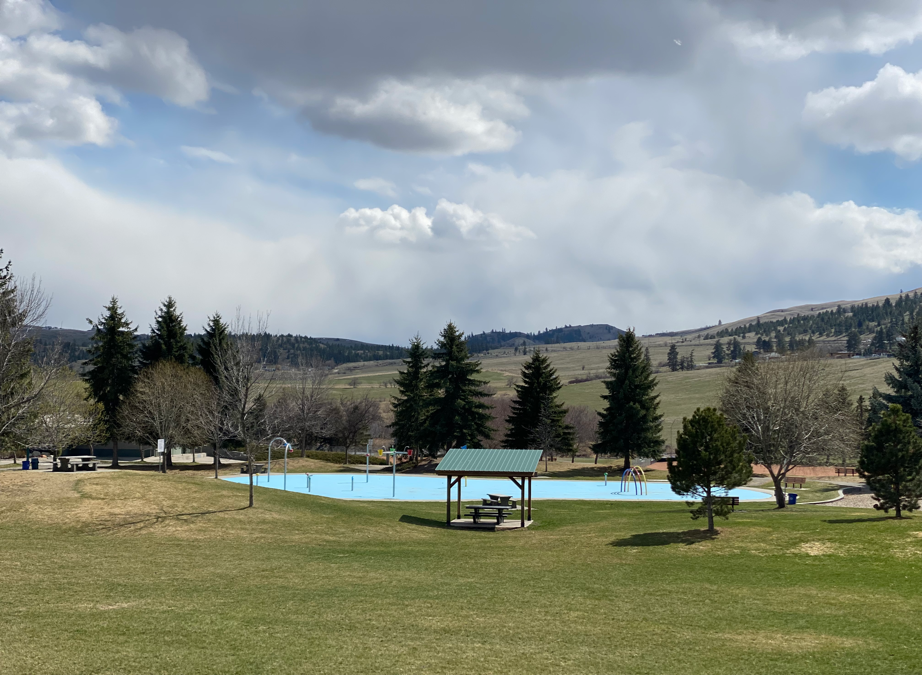1 Albert McGowan Park
Kaur, Arwinddeep
Introduction
“Green infrastructure is an interconnected network of waterways, wetlands, woodlands, wildlife habitats, and other natural areas; greenways, parks, and other conservation lands; working farms, ranches, and forests; and wilderness and other open spaces that support native species, maintain natural ecological processes, sustain air and water resources, and contribute to the health and quality of life for people” (Ersoy Mirici, 2022). According to UN population demographics, 56% of the world population resides in urban areas, which is expected to become 68% by 2050. Expansion of urban areas comes at the cost of green areas, and a trade-off is involved. The area under the urban green and blue infrastructure is estimated to be 352 million hectares (Costanza et al., 2014). The main principles of green infrastructure planning are multifunctionality, connectivity, diversity, and integration (Monteiro, Ferreira & Antunes, 2020). These principles resonate well with the urban parks as they are crucial for urban residents’ physical and mental health. This report highlights the economic value of the services provided by Albert McGowan Park in Kamloops, BC.
Urban parks are strategically planned semi-natural ecosystems comprising natural and built capital, which provides the salient flow of services to enhance the social capital and nourish human well-being by reducing the impacts of urban sprawl. Parks provide cultural and recreational services, regulate the local climate, provide refugia for birds, and are essential in water regulations. In the words of Sir Dasgupta, “nature is silent” and has no say in decision-making. Dollar value is an easy way to understand the worth of the services provided by the city’s natural capital and makes it as valuable as building capital, human capital, and social capital for investment decisions. Valuing the flow of services gives nature an edge in a trade-off. Estimating the value is more about conservation and enhancement than commodifying and privatization attempts.

Albert McGowan Park
Albert McGowan Park of Kamloops city [Tk’emlúps te Secwépemc (TteS)] is in the Thompson-Shuswap region of BC. This 9.65 ha community park is in the heart of Upper-Sahali on the Summit Drive, sandwiched between Monteith Drive in the west and Tuxford Drive in the east. This well-planned public landscape, comprising a combination of grey, green and blue infrastructure, is a crucial provider of ecosystem services to the community. It serves as a playground and sporting event venue for children, having a water spray park, three baseball diamonds, two mini soccer fields, and a vast open green playground. Hall Rogers Community centre, well-maintained short trails, picnic benches, public washrooms, and free parking are lucrative for adults accompanying children or coming for a walk. The pristine Gambles Pond in the park is home to riparian vegetation and nearly 25 bird species (Hunt, 2022). It is a mid-way resting place for migrating Sandhill Cranes, alluring the bird watchers.

Methodology
This study is based on the methodology developed by Sutton and Anderson (2016). This method uses the benefit transfer method; the opportunity cost of not having real estate development at the park is used as a proxy for the minimum value of the ecosystem services provided by the urban park. This assumption is applied to avoid errors in measurement due to the complementary nature of the services. The land value of every third house, starting from the summit drive, is utilized to obtain the mean land value per ha for the park. Data for 26 detached residential houses in the park’s proximity is sourced from the BC Assessment website.
Table 1: Descriptive Statistics of 26 Residential Houses at Albert McGowan Park
| Variable | Mean | StDeviation | Minimum | Maximum | Q1 | Median | Q3 |
|---|---|---|---|---|---|---|---|
| Land Value | $291,200 | $29,327 | $257,000 | $370,000 | $267,000 | $291,000 | $303,000 |
| Building Value | $411,040 | $86,467 | $286,000 | $583,000 | $335,000 | $404,000 | $484,000 |
| Year Built | 1989 | 3.7 | 1983 | 1993 | 1987 | 1992 | 1992 |
| Size in Ha | 0.061 | 0.016 | 0.04 | 0.11 | 0.05 | 0.06 | 0.06 |
| Land Value/Ha | $4,973,523 | $787,970 | $3,274,125 | $6,967,606 | $4,808,988 | $4,960,116 | $5,236,591 |
Results and Discussion
The estimated land value of Albert McGowan Park is $4,973,523/Ha. The minimum market value of the parkland is nearly $47,994,497. A 5% return on this value of the natural capital will provide the ecosystem services worth $2,399,724 per year, as proposed by Sutton and Anderson (2016). ESVD database built on well-reviewed literature puts a value of $138,000/Ha/Year on the ecosystem services provided by urban parks and forests. In this regard, in a single day, our community park provides services worth $3,648. Given that the cost of operating the park in a year is just a fraction of this minimum benefit range of $1.3 – $ 2.4M, there is a huge net benefit to the city residents from the existence of this park.

Conclusion
The population of Kamloops city grew 8.4% in 5 years from 2016 to 2021 (Statistics Canada, 2022). This increase is higher than the Official Community Plan’s estimation of 6%. Optimum utilization of stretched resources could be a tightrope walk for the fast-growing city. For the transparency of the investment decisions in natural capital, knowing the benefits in monetary terms is worthwhile. Albert McGowan Park is a $48M natural capital asset of the city, delivering services of more than $1.3-2.4M in a year. The social yield of 2.7% from this park is higher than the short-term government bonds and higher than the inflow if the city decides to open it for development in the next 20-36 years. This rate of return on natural capital will increase with increasing social capital. Further studies on revealed preferences can highlight the most valued aspects of ecosystem service of local parks by city residents.
References
Costanza, R., de Groot, R., Braat, L., Kubiszewski, I., Fioramonti, L., & Sutton, P. et al. (2017). Twenty years of ecosystem services: How far have we come and how far do we still need to go?. Ecosystem Services, 28, 1-16. doi: 10.1016/j.ecoser.2017.09.008
Ersoy Mirici, M. (2022). The Ecosystem Services and Green Infrastructure: A Systematic Review and the Gap of Economic Valuation. Sustainability, 14(1), 517. doi: 10.3390/su14010517
Hunt, G. (2022). Field Trip To Gamble Pond. Retrieved 11 April 2022, from https://www.kamloopsnaturalistclub.com/field-trip-to-gamble-pond/
Sutton, P., & Anderson, S. (2016). Holistic valuation of urban ecosystem services in New York City’s Central Park. Ecosystem Services, 19, 87-91. doi: 10.1016/j.ecoser.2016.04.003
BC Assessment. (2022). BC Assessment – Independent, uniform, and efficient property assessment. Retrieved 11 March 2022, from https://www.bcassessment.ca/Property/Info/QTAwMDBOV0dUTg==

